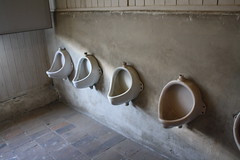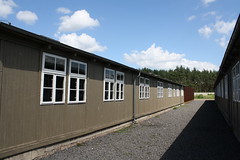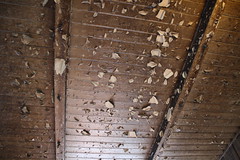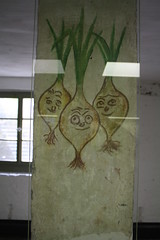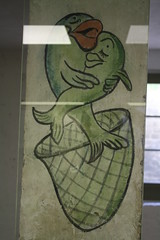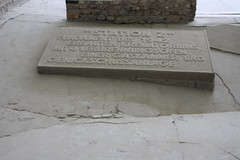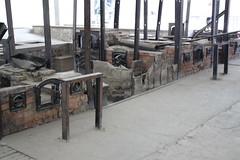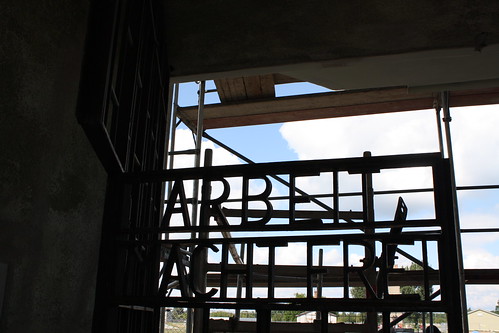
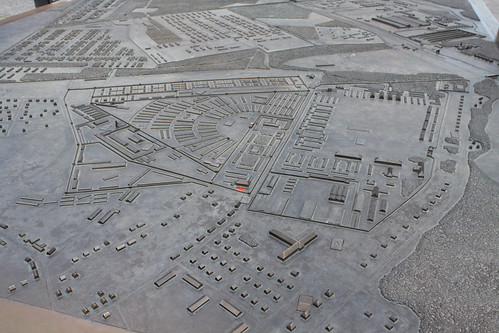
While in Berlin, I took a tour of the Schsenhausen concentration camp through Insider Tours, a tour company that offers fantastic (and cheap) walking tours in a variety of languages.
Schsenhausen was the first facility built as a concentration camp. Just outside Berlin, it replaced a lot of temporary facilities in existing buildings with a large facility custom designed for its purpose. The main feature was triangular layout (above) which allowed an SS guard just above the gate to see the entire prison yard and aim a giant machine gun anywhere he liked.
Schsenhausen was a work camp. Prisoners were used for free labor and as test subjects for horrible inhumane experiments. It began as a camp for political prisoners, but it also grew to include Jews, gays, the handicapped, and social outcasts. All of these people were mixed in with murderers, rapists, etc. sent from other prisons in Germany. Eventually POWs were included as well.
300 or so prisoners — all male — were crammed into fairly small buildings. I say fairly small because they don’t look too small from the outside, but inside there were probably 50 or so tourists and it was difficult to move around. It’s hard to imagine how cramped it would have been with 6 times as many people.
One of the remaining buildings was torched a few years ago by a neo-Nazi. It’s since been rebuilt and turned into a museum, but many burned parts including the peeling paint above remain as a memory.
A large building contained the kitchen in a basement. There’s a number of happy murals here which seem in stark contrast to the concentration camp. It’s not known exactly when or why these were painted. They’re now preserved behind glass.
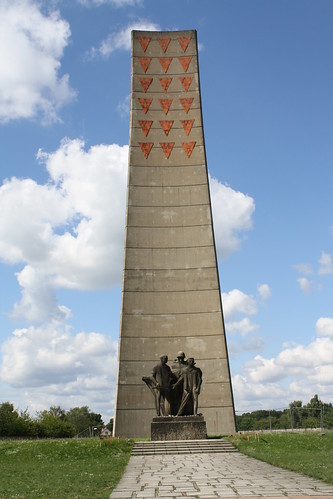
After the Soviets took over half of Germany, they built this hideous thing on the site to memorialize the prisoners — but only the political prisoners. Red triangles were worn on the uniforms of political prisoners. Other prisoners wore different colors. The statue represents a working-class man communist rescued by a Soviet soldier and a politician.
Station Z was called “Z” because it’s the last letter in the alphabet, and it corresponded to the end of life for prisoners who were sick or had grown weak or injured. Originally prisoners were simply mowed down by machine guns in a ditch, but this was determined to be “inhumane.” Not to the prisoners of course, but to the guards who felt bad about just shooting defenseless people.
So they built a new Station Z, which was disguised as a medical office. Prisoners entered and were examined by a fake doctor. They were sent into another room with thick walls, where their skulls were measured. A second fake doctor would enter and look at the prisoner facing away from him (so he didn’t have to make eye contact) and shoot the prisoner exactly in the base of his skull with a small pistol. This minimized the mess. Later, they started experimenting with gassing prisoners using fake “showers” in the same building.
The dead bodies were then sent to be cremated in the next room. To make money, the Nazis sold the remains to their families with a fake death certificate. The workload was too high to clean the cremation furnaces after every use, so the remains were likely a mix of several people.

The Nazis claimed they did an autopsy on every prisoner, but in reality they only did autopsy on prisoners with unusual bodies or those who they had performed surgical experiments on. Above is one of the two autopsy beds in the camp.
End of the camp
When the Soviets began to win the war, the Nazis moved prisoners out of far away concentration camps to Schsenhausen. The camp became overcrowded despite the SS’s best efforts at killing as quickly as possible. But it was too late; they were surrendering. The remaining SS soldiers marched the prisoners out into the forest, then told everyone to go to sleep. The soldiers ran away in the middle of the night.
Once the Soviets had taken over, they used the prison camp for a while as their own to hold Nazis and other political prisoners. Thousands of Soviet prisoners were buried in a mass grave near the site. Eventually they shut down the camp, and most of what remained was lost in the next few years before the GDR government turned it into a memorial site.
Read more about this horrible place at Wikipedia.

